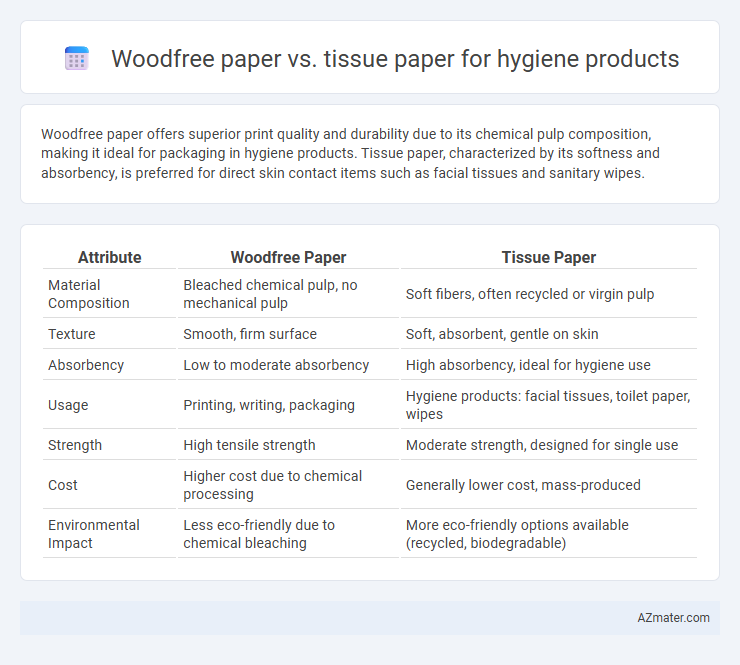Woodfree paper offers superior print quality and durability due to its chemical pulp composition, making it ideal for packaging in hygiene products. Tissue paper, characterized by its softness and absorbency, is preferred for direct skin contact items such as facial tissues and sanitary wipes.
Table of Comparison
| Attribute | Woodfree Paper | Tissue Paper |
|---|---|---|
| Material Composition | Bleached chemical pulp, no mechanical pulp | Soft fibers, often recycled or virgin pulp |
| Texture | Smooth, firm surface | Soft, absorbent, gentle on skin |
| Absorbency | Low to moderate absorbency | High absorbency, ideal for hygiene use |
| Usage | Printing, writing, packaging | Hygiene products: facial tissues, toilet paper, wipes |
| Strength | High tensile strength | Moderate strength, designed for single use |
| Cost | Higher cost due to chemical processing | Generally lower cost, mass-produced |
| Environmental Impact | Less eco-friendly due to chemical bleaching | More eco-friendly options available (recycled, biodegradable) |
Introduction to Hygiene Paper Products
Hygiene paper products consist primarily of woodfree paper and tissue paper, each designed for specific purposes such as facial tissues, toilet paper, and paper towels. Woodfree paper, produced from chemical pulp with most lignin removed, offers smoothness and strength, making it ideal for premium hygiene products requiring durability and softness. Tissue paper, usually made from recycled fibers or a blend of hardwood and softwood pulp, provides absorbency and softness essential for comfort in personal hygiene applications.
What is Woodfree Paper?
Woodfree paper is a high-quality paper made from chemical pulp, which has had most of the lignin removed to improve brightness and durability. This type of paper is commonly used in printing, writing, and hygiene products due to its smooth texture and strength. Unlike tissue paper, woodfree paper offers superior printing surfaces and is less absorbent, making it ideal for products requiring durability and a clean appearance.
What is Tissue Paper?
Tissue paper is a lightweight, soft, and absorbent material primarily made from wood pulp designed for hygiene products such as facial tissues, toilet paper, and napkins. Unlike woodfree paper, which is typically untreated and used for printing or writing, tissue paper undergoes processes to enhance softness, absorbency, and biodegradability. Its specialized manufacturing ensures optimal comfort and skin-friendliness, making it ideal for personal care applications in hygiene products.
Key Differences: Woodfree Paper vs Tissue Paper
Woodfree paper is a high-quality, uncoated paper primarily used in printing and packaging, characterized by its smooth surface and durability due to the absence of mechanical pulp. Tissue paper, designed specifically for hygiene products, is soft, absorbent, and lightweight, often manufactured through creping processes to enhance softness and flexibility. The key differences lie in their functionality: woodfree paper excels in strength and printability, while tissue paper prioritizes softness and absorbency essential for personal care applications.
Production Processes Compared
Woodfree paper is primarily produced through chemical pulping, where lignin is removed to create a smooth, high-quality cellulose fiber ideal for printing and writing. Tissue paper production involves mechanical or chemical pulping combined with creping processes that produce a soft, absorbent, and flexible texture suitable for hygiene products. The creping process in tissue paper manufacturing enhances softness and absorbency, unlike woodfree paper, which emphasizes strength and smoothness through extensive chemical treatment.
Absorbency and Strength in Hygiene Applications
Woodfree paper offers superior strength due to its long fibers and lack of mechanical pulp, making it ideal for hygiene products that require durability. Tissue paper, while less strong, provides excellent absorbency because of its porous structure and softness, essential for effective moisture retention in hygiene applications. Balancing the strength of woodfree paper with the absorbency of tissue paper is crucial for producing high-performance hygiene products.
Softness and Comfort: User Experience
Woodfree paper offers a smooth, durable texture ideal for printed materials but lacks the softness needed for hygiene applications. Tissue paper is engineered for enhanced softness and absorbency, ensuring superior comfort and gentle touch during use. The difference in fiber processing makes tissue paper more suitable for user-sensitive hygiene products, significantly improving overall comfort and skin compatibility.
Environmental Impact and Sustainability
Woodfree paper, made primarily from chemical pulp without mechanical wood fibers, offers higher strength and durability but involves intensive chemical processing that can impact water quality and energy consumption. Tissue paper, often biodegradable and sourced from recycled or sustainably managed wood fibers, typically has a lower environmental footprint due to reduced chemical use and faster decomposition rates. Choosing tissue paper for hygiene products supports sustainability goals through enhanced recyclability, reduced resource extraction, and minimized landfill waste.
Cost Comparison and Market Trends
Woodfree paper, known for its higher durability and print quality, generally incurs greater production costs compared to tissue paper, which is optimized for softness and absorbency in hygiene products. Tissue paper dominates the hygiene market due to its cost-effectiveness and consumer preference for comfort, driving innovation in biodegradable and premium softness variants. Market trends indicate a growing demand for sustainable tissue paper, with manufacturers investing in eco-friendly raw materials and cost-efficient production techniques to maintain competitive pricing.
Choosing the Right Paper for Hygiene Products
Woodfree paper offers a smooth, strong base ideal for printing hygiene product packaging, ensuring clarity and durability, while tissue paper excels in softness and absorbency, making it suitable for direct skin contact in products like facial tissues and toilet paper. Selecting the right paper depends on the hygiene product's purpose, with woodfree paper preferred for packaging and tissue paper chosen for products requiring gentle touch and high absorbency. Manufacturers must balance factors such as strength, softness, and biodegradability to optimize performance and consumer satisfaction in hygiene items.

Infographic: Woodfree paper vs Tissue paper for Hygiene product
 azmater.com
azmater.com